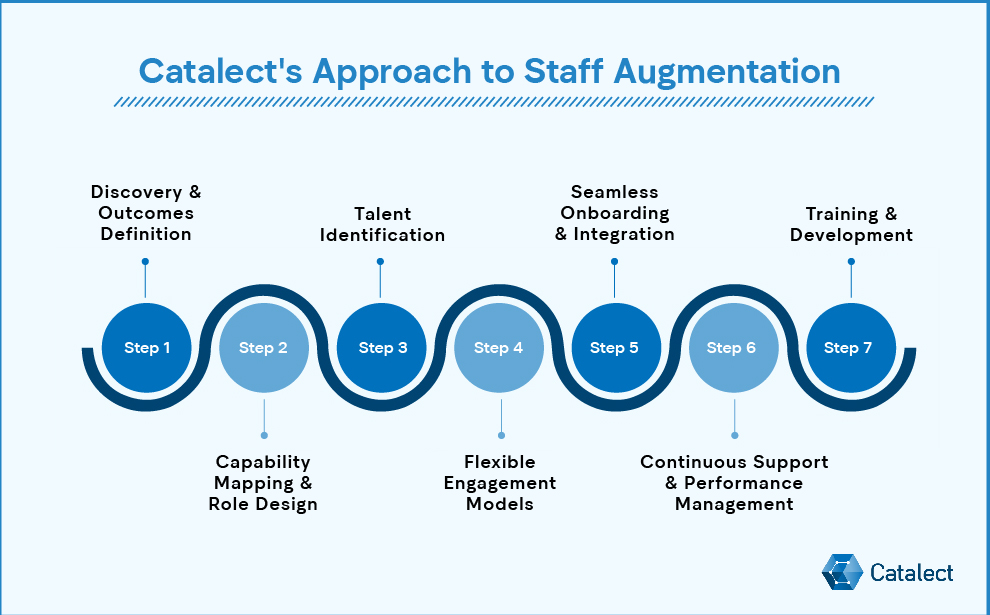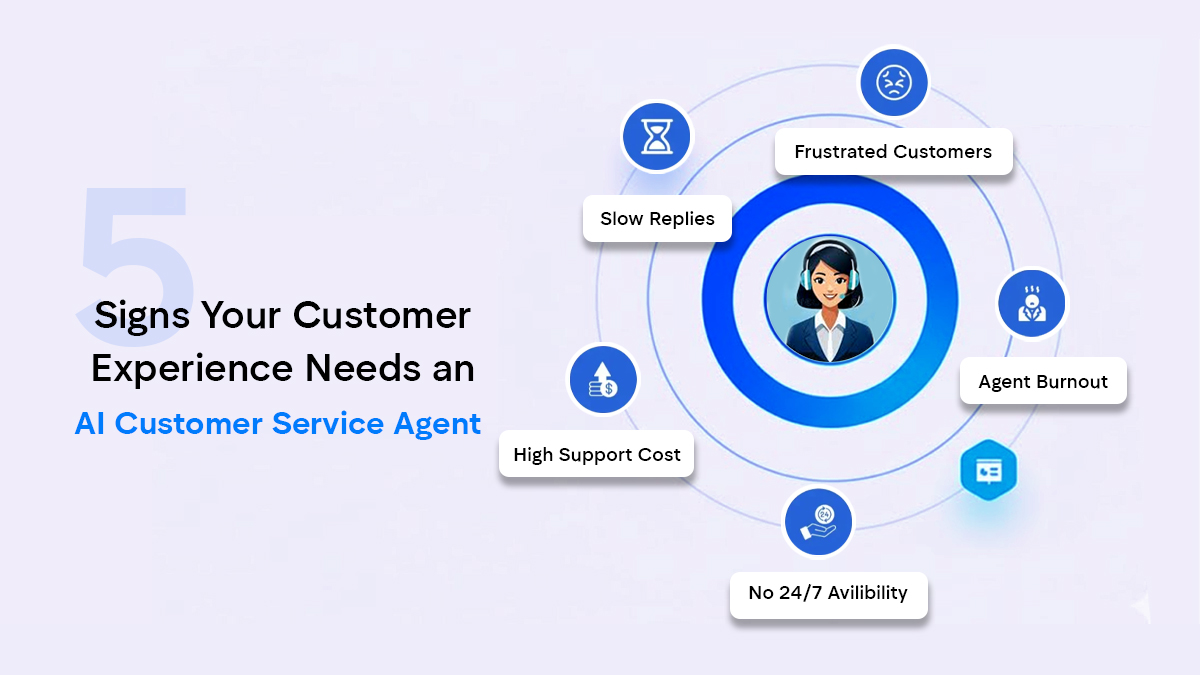The pace of business has never been faster.
Yet, as McKinsey notes, 60% of companies cite the scarcity of tech talent and skills as a key inhibitor of digital transformation. One month, a company is racing to launch a new product; the next, it’s scrambling to find cybersecurity experts after a surprise compliance update. Teams stretch thin, deadlines tighten, and hiring starts to feel like running uphill through molasses.
In this environment, speed alone isn’t enough. Organizations need access to the right talent exactly when they need it. That’s where staff augmentation comes in. It is fast becoming the competitive edge for companies seeking agility without compromise, allowing them to scale quickly, integrate specialists seamlessly into existing workflows, and balance speed, quality, and cost with precision.
In this new era of work, staff augmentation isn’t about filling gaps; it’s about workforce optimization and enabling organizations to stay adaptive, resilient, and future-ready.
The Rise of Staff Augmentation: How Companies Stay Agile in a Talent-Scarce World
Staff augmentation is a flexible workforce model in which an organization strengthens its team with external professionals (contractors, consultants, or specialists) for defined durations or specific roles. These experts integrate into internal workflows under the client’s management, allowing agility without losing control.
According to Business Research Insights, the global IT staff augmentation market was valued at USD 383.5 billion in 2025 and is projected to reach USD 1.24 trillion by 2035, a 13.2% CAGR underscoring just how rapidly this model is scaling worldwide.
This flexible approach to team building is at the heart of staff augmentation services, which allow organizations to quickly adapt, reduce hiring delays, and access niche skills as business needs evolve.
(For a deeper look at how this model works in real projects, explore Catalect’s Staff Augmentation Services).
How Staff Augmentation Differs from Outsourcing or Managed Services?
1. Outsourcing
You hand over an entire process or function to a third-party vendor who manages it independently, often with limited visibility or control over how things get done.
Advantages : Ideal for standardized tasks such as payroll, customer service, or back-office operations. Outsourcing improves cost efficiency and allows businesses to focus on strategy while leveraging external expertise.
2. Managed ServicesT
he vendor takes full ownership of an end-to-end process (usually governed by SLAs), focusing on outcomes rather than individual talent.
Advantage: Suited for complex, ongoing needs like IT infrastructure, cybersecurity, or cloud management. Managed services deliver predictable results, measurable outcomes, and proactive performance improvements.
3. Staff Augmentation
You stay in control. The external professionals join your team, follow your workflows, and align with your goals, giving you flexibility without losing oversight.
In short, staff augmentation lets you stay agile. You get the expertise you need, when you need it, while keeping full control over how that work fits into your business.
Traditional Hiring Struggles and How Staff Augmentation Solves Them

1. Manual Sourcing Inefficiency
Traditional hiring can feel like a marathon, posting role, sifting through endless resumes, rounds of manual screening, and long lead times. It’s a slow, repetitive, and often inefficient process. Staff augmentation vendors maintain pre-vetted pools of skilled professionals who are ready to step in, reducing sourcing overhead and helping you move from search to delivery faster.
2. Skills mismatch
In full-time hiring, you may find a great candidate who’s missing niche expertise or needs months to ramp up. With external resource augmentation, you can select specialists whose profiles precisely match your project. Whether it’s a cloud architect, a UX researcher, or a data analyst, you get people whose skills fit the project from day one, reducing the risk of mismatch and saving valuable time.
3. Long hiring cycles
Full time hiring may take weeks or months and when project deadlines are looming, that delay can cost you opportunities. Staff augmentation services enable rapid onboarding of external specialists, often in days or weeks, helping you meet critical timelines and maintain momentum.
4. Lack of data-driven decision-making
Many workforce decisions are intuitive rather than analytical. Augmentation providers increasingly use talent platforms, skills-mapping and performance analytics to match the right people to the right projects and track success, helping you make better, data-backed choices.
According to a study by Deloitte, companies can save up to 20-30% on labor costs through staff augmentation compared to traditional hiring.
In short, staff augmentation gives organizations the flexibility to fill skill gaps, scale fast, and optimize workforce decisions without the long hiring cycles, overhead, or uncertainty of traditional recruitment.
Key Trends Shaping Staff Augmentation in 2025
.jpg)
1. Hybrid/Remote Delivery Models
Work is no longer confined to one office or country. Today’s staff augmentation models blend onshore, nearshore, and offshore talent, giving organizations access to the right expertise at the right cost, wherever it exists. This hybrid approach not only improves efficiency but also makes it easier to find niche skills without geographic limits.
2. Shift to Skills-Based Hiring
Job titles are becoming less important than what people can actually do. Companies are increasingly defining roles by skill sets, like (React + Accessibility” or “Cloud native + Kubernetes + FinOps). This shift toward skills-based hiring makes staff augmentation even more valuable, allowing organizations to plug in specialists with the exact capabilities a project needs.
3. Outcome-Based Engagement Models
More companies are moving beyond traditional “time and materials” contracts. Instead, they’re focusing on outcome-based staff augmentation models where success is measured by deliverables, KPIs, and tangible results. This trend aligns augmented teams more closely with business goals, creating partnerships that focus on value and impact rather than just hours logged in.
4. Compliance, Security, and Global Talent Pools
As global teams become the norm, so do global responsibilities. Organizations now place greater emphasis on data privacy, regulatory compliance, and secure collaboration across borders, which drives the need for robust solutions. In response, staff augmentation providers are strengthening governance, building vetted vendor networks, and developing clear geo-talent strategies, ensuring that companies can scale safely and confidently, wherever their teams operate
Key Innovations & Capabilities Advancing Staff Augmentation
1. Smart Matching and Talent-Sourcing Tools
Modern staff augmentation platforms now use intelligent algorithms, skills profiling, and predictive analytics to match the right professional to the right project, quicker and with greater accuracy. This means you’re not just hiring quickly; you’re hiring smartly, with data-driven insights that improve fit and performance from the start.
Modern staff augmentation platforms use intelligent algorithms, skills profiling, and predictive analytics to match the right professionals to the right projects faster and with greater accuracy. This approach ensures you're not just hiring quickly but hiring smartly. As one of the top-tier IT staff augmentation companies, we combine these advanced tools with a tailored approach to deliver the best-fit talent for your projects, improving performance and ensuring smooth execution from the start.
2. Flexible Contract and Delivery Models
Today, flexibility isn’t optional; it’s essential. Companies can choose onshore, nearshore, or offshore delivery models based on their priorities: cost, risk, time-zone overlap, or specialized expertise. Building the right balance between efficiency and control. These flexible staff augmentation models allow organizations to evolve in sync with changing business demands.
Flexibility has become a key driver of business success. Companies can choose from onshore, nearshore, or offshore delivery models based on their priorities, such as cost, risk, time-zone alignment, or access to specialized expertise. The goal is to find the right balance between efficiency and control. These adaptable staff augmentation models enable organizations to stay in sync with the ever-changing demands of the business world.
3. Internal-External Talent Marketplaces and Redeployment
Forward-thinking organizations view staff augmentation services as part of a larger talent ecosystem, where internal mobility, external specialists, and dynamic project teams all work in sync. This approach allows companies to move people where they’re needed most, ensuring agility without constantly rebuilding teams from scratch.
4. Data-Driven Workforce Planning and Analytics
Analytics are reshaping staff augmentation workforce optimization. Organizations are using data to forecast future skill needs, track the performance of augmented professionals, and fine-tune the balance between permanent and external staff. This drives smarter planning, stronger teams, and a better alignment of talent with business objectives. Curious to see how an external partner can bring this approach to life? Explore Catalect’s case studies, which highlights real-world workforce solutions.
How to Choose the Right Staff Augmentation Solution for Project Success

1. Partner Evaluation
Choose a partner who feels like an extension of your own team, not just a vendor. Look for one that offers transparent contracts, flexible engagement models (time-based or outcome-based), and alignment with your culture and workflows.
2. Onboarding and Integration
Treat augmented professionals as part of your team from day one. Give them access to the same tools, communication channels, and project goals as internal staff. When they feel included, they work with greater ownership and accountability, turning “outsourced” help into true partners in execution.
3. Performance Measurement and Retention
Success doesn’t end up hiring the right talent; it’s about keeping them motivated and aligned. Set clear KPIs, track performance consistently, and encourage open feedback loops. Even with external specialists, engagement, and recognition matters. Maintain documentation, manage turnover proactively, and ensure smooth knowledge transfer, so projects stay on track no matter who’s on the team.
When to Integrate Staff Augmentation into Your Workflow
Use staff augmentation when you are:
- Scaling rapidly and need specialized skills you don’t currently own.
- Facing skill shortages or long hiring lead-times in competitive markets.
- Launching new products or entering new markets where speed and flexibility matter.
- Seeking workforce agility with fast ramp-up and minimal long-term commitments.
- Looking to optimize costs and reduce hiring risk while maintaining control.
For businesses wondering when to use staff augmentation, the answer is simple: any time agility, speed, or niche expertise becomes a strategic advantage.
Catalect's Approach to Staff Augmentation
Workforce transformation begins with clarity. Catalect focuses on understanding what each business aims to solve and why it matters before assigning resources. Our staff augmentation strategy combines a global network of skilled professionals, deep expertise across multiple technology stacks, and transparent pricing. This thoughtful, insight-led approach helps businesses unlock the true potential of IT staff augmentation, building teams that perform and evolve with organizational goals.
Our approach is built on the following principles:

1. Discovery and Outcomes Definition
Every engagement begins with clarity. The process starts by identifying the core challenge, defining measurable outcomes, and setting success metrics to ensure every staffing decision contributes to business impact.
2. Capability Mapping and Role Design
Outcomes are translated into defined capabilities, roles, and key performance indicators. This step ensures that each professional contributes meaningfully to the organization’s strategic objectives.
3. Talent Identification
Leveraging Catalect’s global talent network, professionals are sourced and evaluated based on technical mastery, domain experience, and cultural alignment. Skills profiling and scenario-based assessments ensure the right expertise is placed on every project.
4. Flexible Engagement Models
Onshore, nearshore, and offshore delivery options allow organizations to balance cost, capability, and time-zone alignment. Engagements can be structured on a part-time, full-time, or project-based basis depending on business priorities.
5. Seamless Onboarding and Integration
Structured onboarding and secure collaboration frameworks ensure that new professionals integrate smoothly into existing workflows. With clear communication routines and standardized processes, teams align quickly, maintain compliance, and begin contributing measurable outcomes from day one
6. Continuous Support and Performance Management
At Catalect, we provide ongoing governance through check-ins, feedback cycles, and KPI reviews. Teams remain adaptive as priorities evolve, ensuring sustained performance and accountability. Throughout each engagement, we also document key insights and outcomes to support smooth knowledge transfer and long-term value realization.
7. Training and Development
Augmented professionals receive continuous learning and upskilling in emerging technologies, frameworks, and best practices, keeping delivery quality high and ensuring long-term value for every engagement.
Conclusion
Staff augmentation has evolved from a quick fix into a strategic capability for organizations that value agility, precision, and scale. By combining external expertise, flexible staff augmentation models, and data-driven management, businesses can create workforce ecosystems that adapt in real time.
As we move into 2025 and beyond, the companies that view staff augmentation services not as “adding more people” but as “optimizing how we work” will lead the way, building smarter, leaner, and more resilient teams ready for whatever comes next.
At Catalect, we believe in a consultative approach where understanding your unique challenges allows us to identify the right mix of resources and expertise to achieve your goals. This tailored solution ensures smoother project delivery and aligns talent with your business strategy, driving long-term success.
Want to operationalize flexible staff augmentation models and integrate external expertise with precision? Contact Catalect to explore how our services can help you redefine your workforce strategy.







